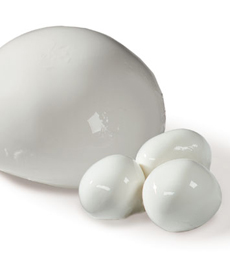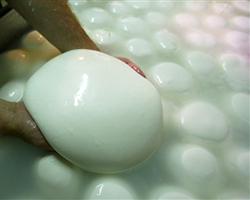
 These gleaming balls of mozzarella are from The Mozzarella Company in Texas, which ships its products nationwide. Perishable cheeses like mozzarella should be kept refrigerated; generally they will remain fresh for two to three weeks. If the cheeses are vacuum-packed they may be stored for up to three weeks prior to opening. Once opened they will last 7 to 14 additional days. In a pinch, mozzarella can be frozen; it should be defrosted slowly in the refrigerator. These gleaming balls of mozzarella are from The Mozzarella Company in Texas, which ships its products nationwide. Perishable cheeses like mozzarella should be kept refrigerated; generally they will remain fresh for two to three weeks. If the cheeses are vacuum-packed they may be stored for up to three weeks prior to opening. Once opened they will last 7 to 14 additional days. In a pinch, mozzarella can be frozen; it should be defrosted slowly in the refrigerator.
|
STEPHANIE ZONIS focuses on good foods and the people who produce them.
|
|
May 2006
Updated September 2009
|
 |
Mozzarella Cheese
Page 2: Making Fresh Mozzarella
This is Page 2 of a five-page article. Click on the black links below to visit other pages.
Making Fresh Mozzarella Cheese
Production of mozzarella is swift in comparison to that of many other cheeses. Virtually all mozzarella is made from pasteurized milk these days (because the cheese is not an aged one, U.S. law requires all mozzarella sold here to be made from pasteurized milk—raw milk cheeses must be aged for 60 days prior to sale).
Through a combination of acidification and/or heat and enzymes, the milk is curdled, then drained of whey. The curd is broken into smaller parts, then ground into crumbly bits. These bits are combined with hot water, and they are stirred until they become one mass of rubbery texture. Following this, a cheesemaker stretches the mass of curd with his hands, a key step requiring both knowledge and skill. Stretching (often called “kneading”) for too short or too long a time will adversely affect the quality of the finished cheese. When it is finished, the curd should be smooth and shiny. A “rope” of the curd is pulled from the rest of the mass, cut off (remember the definition of “mozzare”), and shaped, usually into a ball.
 The ball is placed in cold water so it cools rapidly and holds its shape. This is followed by a quick soak in brine, where the mozzarella absorbs some salt. Remember that mozzarella does not require aging, so it’s ready for consumption after the brine soak. The entire process usually takes about eight hours. Ideally, fresh mozzarella should be consumed within a day or, at most, two days. The ball is placed in cold water so it cools rapidly and holds its shape. This is followed by a quick soak in brine, where the mozzarella absorbs some salt. Remember that mozzarella does not require aging, so it’s ready for consumption after the brine soak. The entire process usually takes about eight hours. Ideally, fresh mozzarella should be consumed within a day or, at most, two days.
Photo of mozzarella in brine courtesy of Wisconsin
Milk Marketing Board.
A fresh mozzarella is soft and moist, mild and milky-tasting, almost oozing with watery butterfat. But what happens when highly perishable fresh cheese meets ever-increasing consumer demand and industrialization? Modern production techniques, including pasteurization and vacuum sealing, allow mozzarella made from both cow and water buffalo milk to be shipped long-distance and have a far longer shelf-life, but as with corn fresh-picked from the field hours earlier versus corn that reaches you the next day, a sharp palate can perceive a diminution.
But you’ll be assured of good quality if what you buy is labeled as “fresh” mozzarella, won’t you? Nope. A lot of today’s “fresh” mozzarella is industrially produced; this is often the cheese you find vacuum-sealed. It’s also possible to purchase ready-made mozzarella curds that one can place in hot water and stretch/knead to a “fresh” mozzarella state. This mode of “making” mozzarella is popular with some lunch counters or delis, and, in some cases, produces a cheese I find very good. There’s even a business that will sell you a mozzarella-making kit, although I had very poor results with this. The number of companies producing mozzarella via more traditional methods remains limited, however, and I can find only two companies in the U.S. making mozzarella di bufala (and of those two, only one ships directly to consumers).
NOTE: A buffalo is, correctly, a water buffalo that produces milk; the species include the Asian water buffalo, used for cheese, and the African water buffalo. The animal that roamed the Great Plains of America is a bison. Read the difference.
Continue To Page 3: Types Of Mozzarella
Go To The Article Index Above
Lifestyle Direct, Inc. All rights reserved. Images are the copyright of their respective owners. 
|





 The ball is placed in cold water so it cools rapidly and holds its shape. This is followed by a quick soak in brine, where the mozzarella absorbs some salt. Remember that mozzarella does not require aging, so it’s ready for consumption after the brine soak. The entire process usually takes about eight hours. Ideally, fresh mozzarella should be consumed within a day or, at most, two days.
The ball is placed in cold water so it cools rapidly and holds its shape. This is followed by a quick soak in brine, where the mozzarella absorbs some salt. Remember that mozzarella does not require aging, so it’s ready for consumption after the brine soak. The entire process usually takes about eight hours. Ideally, fresh mozzarella should be consumed within a day or, at most, two days.